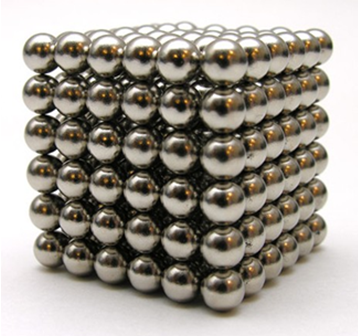Contrary to their name, rare-earth magnets are not made from rare materials; they are nevertheless the most powerful permanent magnets. The term “rare-earth” originates from the 17 elements in the periodic table used in making the magnets: the 15 lanthanides, scandium, and yttirum.
Rare-earth magnets are available in two types: samarium-cobalt or neodymium, and are excessively brittle and susceptible to corrosion. For this reason, the magnets must be plated.
Compared to traditional ferrite and ceramic magnets, the magnetic field produced by rare-earth magnets is considerably stronger, measuring 1.4 teslas, the unit of measuring magnetic flux density, versus the 0.5 to 1.0 tesla of the other two.
Type 1 Samarium-cobalt
Samarium-cobalt magnets are the first class of rare magnets invented. Higher cost and weaker magnetic field than neodymium magnets, makes samarium-bolts less popular than the latter; however, this types of magnet has a higher Curie temperature, making it ideal for use in “applications where high field strength is needed at high operating temperatures.” Do note that while Samarium-cobalt magnets may resist oxidation, they are prone to chipping and cracking because they are brittle.

Neodymium magnetic spheres arranged in a cube; image courtest of Orbtronic.
Type 2 Neodymium
Neodymium are both the strongest and cheapest type of rare-earth magnet. Neodymium magnets created from a combination of the alloy of neodymium, iron, and boron. This type of magnet is primarily used in jewelry clasps, magnetic hold downs, hard drives, and electric motors for cordless tools, as they strong and compact permanent magnets.
Compared to samarium-cobalt magnets, neodymium magnets exhibit a higher magnetic field strength at the cost of a lower Curie temperature and higher vulnerability to oxidation. Nevertheless, the magnets may be coated in a protective layer made from gold, nickel, zinc, or tin plating and epoxy resin coating to protect against corrosion.
The price of neodymium magnets was significantly higher prior to the 1990's, but expiring patents opened up commerce to more manufacturers, thus creating the competition necessary to lower prices.
Application
Rare-earth magnets are being increasingly used in applications requiring powerful magnets such as audio speakers, headphones, bicycle dynamos, high-performance AC servo motors, hard drives, linear motors, electrodynamic bearings, launched roller coasters, and even in toys such as miniature figures.. This strength allows the magnets to be smelted into a smaller and lighter size.
How are they built?
Once the raw material is grounded, it is combined in various mixtures to create materials of varying grades of magnetism, durability, and Curie temperature.
The resulting mixture is then pressed together into a form. Afterwards, a large electromagnetic is used to arrange the atomic particles and their electron spin in a specific direction. Next everything is sintered to form a solid object by heating the powder right below its melting temperature thereby forcing the atoms to fuse together into a solid piece.
Now that a solid shape has been established, it can be milled to the desired dimensions. At this point the soon-to-be magnet must be plated to protect against corrosion; nickel, copper + nickel, epoxy coating, gold, zinc, or ABS plastic, are all adequate plating materials.
By this stage the materials ready to be magnetized. Do note that neodymium magnets can only be magnetized in the direction that their electrons were aligned in during the preparation stage.
Visit TechXchange to discuss applications for rare-earth magnets.
By Maximilian Teodorescu
Advertisement
Learn more about Electronic Products Magazine





